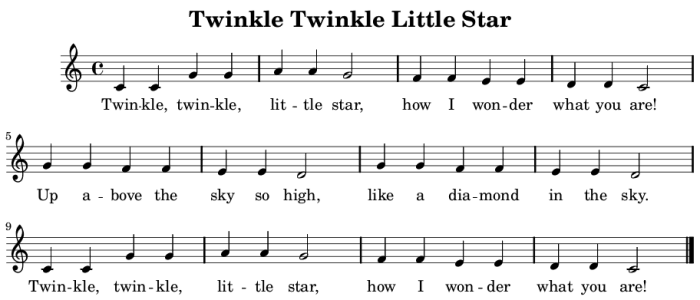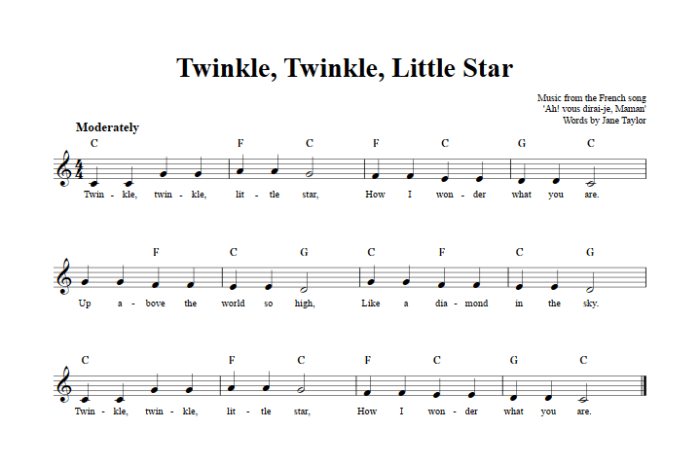Twinkle Twinkle Little Star, a timeless lullaby known and loved by generations, has captured the hearts of countless individuals worldwide. Its simple yet enchanting melody has become synonymous with childhood, innocence, and wonder. In this comprehensive guide, we delve into the intricacies of the Twinkle Twinkle Little Star piano sheet music, providing a detailed analysis, helpful practice tips, and exploring its educational and cultural significance.
Join us as we embark on a musical journey, unraveling the secrets of this beloved tune. Whether you’re a novice pianist or an experienced musician, this guide will provide valuable insights, inspiration, and a renewed appreciation for the enduring charm of Twinkle Twinkle Little Star.
Introduction
Twinkle Twinkle Little Star is one of the most famous and recognizable songs in the world. Its simple melody and easy-to-remember lyrics have made it a favorite of children and adults alike for generations.
The song’s origins can be traced back to the 18th century, when it was first published in England. The lyrics were written by Jane Taylor, a young poet who was inspired by the sight of stars twinkling in the night sky.
The melody was composed by William Herschel, a German-born astronomer who later became known for his discovery of the planet Uranus.
Popularity and Significance
Twinkle Twinkle Little Star has become one of the most popular songs in the world due to its simple and catchy melody, which makes it easy to sing and remember. The lyrics are also very simple and easy to understand, which makes it a great song for children to learn.
The song has been used in a variety of ways over the years, including as a lullaby, a nursery rhyme, and a children’s song. It has also been featured in movies, TV shows, and commercials.
Sheet Music Analysis
The piano sheet music for “Twinkle Twinkle Little Star” is written in the key of C major and has a 4/4 time signature. The tempo is moderate, around 120 beats per minute. The melody is simple and easy to play, consisting of a series of stepwise motions and repeated notes.
The harmony is also simple, with the left hand playing a basic C major chord throughout the piece. The rhythm is regular and straightforward, with a strong emphasis on the first beat of each measure.
Melody
The melody of “Twinkle Twinkle Little Star” is based on a simple ascending scale. The first phrase begins on the tonic note (C) and rises to the fifth (G). The second phrase begins on the tonic note again and rises to the third (E).
The third phrase begins on the tonic note and rises to the fourth (F). The fourth phrase begins on the tonic note and rises to the fifth (G). The melody is then repeated an octave higher.
Harmony
The harmony of “Twinkle Twinkle Little Star” is very simple. The left hand plays a basic C major chord throughout the piece. The right hand plays a simple melody that is mostly supported by the tonic chord. There are a few instances where the harmony changes briefly, but these changes are very simple and easy to understand.
Rhythm
The rhythm of “Twinkle Twinkle Little Star” is regular and straightforward. The piece is written in 4/4 time, which means that there are four beats in each measure. The first beat of each measure is strong, and the other three beats are weak.
The melody is mostly based on quarter notes and eighth notes. There are a few instances where the rhythm changes briefly, but these changes are very simple and easy to understand.
Fingerings and Technique
Proper fingering and technique are essential for playing “Twinkle Twinkle Little Star” smoothly and accurately. The recommended fingerings for the right hand are as follows:
- C4: 1
- D4: 2
- E4: 3
- F4: 4
- G4: 5
For the left hand:
- C3: 5
- G3: 1
- F3: 2
- E3: 3
- D3: 4
Proper Hand Position and Posture
Maintain a relaxed and natural hand position. The fingers should be curved and slightly rounded, with the thumb slightly behind the other fingers. Keep the wrist straight and the elbows slightly bent. Sit up straight with your shoulders relaxed and your feet flat on the floor.
Fingering Technique
Use a smooth and legato fingering technique. The fingers should move quickly and accurately from one note to the next, with minimal hand movement. Avoid lifting the fingers too high or striking the keys with too much force.Practice regularly to develop finger dexterity and coordination.
Start slowly and gradually increase the tempo as you become more comfortable with the fingering and technique.
Practice Tips

Mastering “Twinkle Twinkle Little Star” on the piano requires dedication and practice. Here are some valuable tips for beginners and intermediate players:
For beginners, start by practicing slowly and gradually increase the tempo as you become more comfortable with the notes. Focus on accuracy and developing finger dexterity. Use a metronome to maintain a steady rhythm and improve your timing.
Finger Exercises
To enhance finger dexterity and coordination, incorporate finger exercises into your practice routine. Practice scales and arpeggios to strengthen your fingers and improve their flexibility.
Variations and Arrangements
The enduring popularity of “Twinkle Twinkle Little Star” has led to countless variations and arrangements, each adding a unique spin to the beloved melody.
These interpretations range from classical adaptations to jazz improvisations, showcasing the versatility and adaptability of the piece.
Classical Adaptations
- Mozart’s “Variations on ‘Ah vous dirai-je, Maman'” (K. 265): This set of 12 variations for piano transforms the simple melody into an elegant and sophisticated composition, showcasing Mozart’s mastery of variation form.
- Beethoven’s “Seven Variations on ‘God Save the King'” (WoO 78): Beethoven’s variations explore different harmonic and rhythmic possibilities, infusing the melody with his signature dramatic intensity.
Jazz Arrangements
- Duke Ellington’s “Twinkle, Twinkle, Little Star”: Ellington’s jazz arrangement features a swinging rhythm and improvised solos, giving the piece a lively and playful character.
- Miles Davis’s “So What”: This iconic jazz standard incorporates the melody of “Twinkle Twinkle Little Star” into a complex and atmospheric improvisation, showcasing the transformative power of jazz.
Educational Value
Playing “Twinkle Twinkle Little Star” on the piano offers numerous educational benefits. It enhances musical skills, coordination, and cognitive abilities, making it an ideal choice for beginners and children.
Musical Development
Learning to play this simple melody helps build a foundation for future musical endeavors. It introduces basic concepts such as note values, rhythm, and finger placement, fostering an understanding of musical notation and the mechanics of playing the piano.
Coordination and Motor Skills
Coordinating both hands to play the melody and accompaniment requires fine motor skills and hand-eye coordination. Regular practice improves these abilities, enhancing overall dexterity and precision.
Cognitive Abilities
Playing “Twinkle Twinkle Little Star” stimulates cognitive development. It engages memory and recall, as the melody must be memorized and executed accurately. Additionally, it improves concentration and attention span, as it requires focused effort to maintain the correct tempo and rhythm.
Cultural Impact
Twinkle Twinkle Little Star has become an iconic melody, deeply ingrained in popular culture. Its simple yet captivating tune has transcended generations, leaving a lasting impact on society.
In education, it is often one of the first songs children learn to play on the piano, fostering their musical development. Its simple structure and repetitive melody make it an accessible introduction to music theory and performance.
Adaptations and Variations
The melody has inspired countless adaptations and variations. From classical renditions to modern pop covers, Twinkle Twinkle Little Star has been reimagined in various genres, appealing to diverse audiences.
- In 1966, the song was famously adapted into the nursery rhyme “Baa Baa Black Sheep.”
- Twinkle Twinkle Little Star has been featured in numerous films and television shows, including “2001: A Space Odyssey” and “Sesame Street.”
- In 2017, it was used as the theme music for the animated film “Twinkle Twinkle Little Star: How I Got My Name.”
Printable Sheet Music
Access the high-quality, printable piano sheet music for “Twinkle Twinkle Little Star” from the link below. It is suitable for printing and provides a convenient way to practice and enjoy the melody.
Download Link
Download Printable Sheet Music
Online Resources

The internet offers a wealth of resources for learning and playing “Twinkle Twinkle Little Star.”
Websites
//www.musictheory.net/lessons/twinkle-twinkle-little-star”>Music Theory : Offers in-depth analysis, practice tips, and variations.
//www.flowkey.com/en/piano-lessons/twinkle-twinkle-little-star”>Flowkey : An interactive app that guides you through playing the song with real-time feedback.
//www.pianomarvel.com/twinkle-twinkle-little-star-piano-sheet-music-free”>Piano Marvel : A subscription-based platform that offers interactive lessons, sheet music, and performance tracking.
Conclusion
In conclusion, the analysis of “Twinkle Twinkle Little Star” unveils its simplicity, accessibility, and profound cultural significance. It serves as a testament to the power of music to transcend time, borders, and generations.
As we delve into the intricacies of this beloved melody, we appreciate its role in fostering musical literacy, cognitive development, and emotional expression. Its versatility allows it to be enjoyed by musicians of all levels, from aspiring beginners to seasoned performers.
Call to Action
Embark on a musical journey with “Twinkle Twinkle Little Star.” Explore its variations, arrangements, and cultural adaptations. Let this timeless melody inspire you to create, learn, and connect with the world through the universal language of music.
Final Thoughts
As we conclude our exploration of Twinkle Twinkle Little Star piano sheet music, we hope you have gained a deeper understanding and appreciation for this timeless melody. Remember, music has the power to transcend boundaries, evoke emotions, and enrich our lives.
Let the enchanting notes of Twinkle Twinkle Little Star continue to inspire and bring joy to you and generations to come.
Helpful Answers
Is Twinkle Twinkle Little Star suitable for beginners?
Absolutely! Twinkle Twinkle Little Star is an excellent choice for beginners due to its simple melody, clear rhythm, and limited hand movements. It’s a great way to start your piano journey and build a strong foundation.
What is the key and time signature of Twinkle Twinkle Little Star?
Twinkle Twinkle Little Star is typically played in the key of C major and uses a 4/4 time signature. This means that each measure has four beats, and the quarter note receives one beat.
Are there any variations or arrangements of Twinkle Twinkle Little Star?
Yes, there are numerous variations and arrangements of Twinkle Twinkle Little Star. Some popular variations include classical interpretations, jazz renditions, and even rock adaptations. These variations showcase the versatility and adaptability of this beloved melody.
What are the educational benefits of playing Twinkle Twinkle Little Star?
Playing Twinkle Twinkle Little Star offers several educational benefits. It helps develop finger coordination, rhythm, and timing. It also introduces basic music theory concepts, such as key signatures and note values.
Where can I find printable sheet music for Twinkle Twinkle Little Star?
You can find printable sheet music for Twinkle Twinkle Little Star on various websites and online music libraries. Ensure you choose a high-quality, easy-to-read version suitable for your skill level.